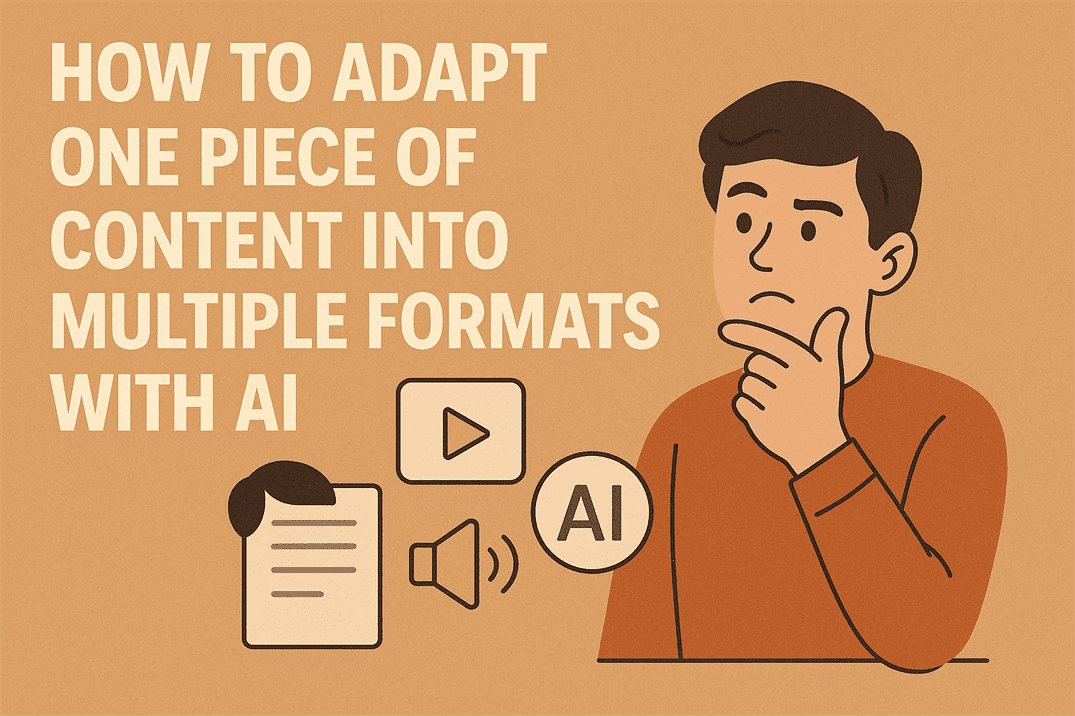How to rewrite content with AI without losing originality

(Or: How to borrow the words without stealing the soul)
The topic of rewriting, plagiarism, originality and copying is huge and far too contentious for this blog.
However, it’s an important topic so I can’t avoid it forever.
What I can do is stick to the facts without getting into ethics or the politics of publishing, so here goes.
Rewriting is like borrowing your friend’s jacket and pairing it with your own scarf, boots, and inexplicable fondness for socks with puns.
Plagiarism is borrowing the jacket, the scarf, the boots… and also pretending you’re the friend.
The trick? Keep the idea essence but filter it through your own brain-voice.
AI can help, but you’ve got to steer it so it’s not just swapping out “happy” for “joyful” and calling it a day.
When rewriting is useful (Updates, repurposing, localisation)
Rewriting has an important place in content. Not only for engagement, but for SEO and now GEO too…
AI-powered rewriting is a hero in three very specific movie plots:
- The update saga – Your old blog post says “in 2019” and uses screenshots from Windows Vista. Time for a glow-up.
- The great repurpose – That epic guide you wrote? It could also be a podcast script, an email sequence, or a TikTok caption if rewritten cleverly.
- The localisation quest – Turning “favorite” into “favourite” and swapping baseball metaphors for cricket ones so UK readers don’t feel like they’re decoding a foreign language.
Feeding AI the right context (Not just the original text)
Here’s the rookie mistake: you paste the old text in and say, “Rewrite this.”
That’s like asking a chef to “make dinner” without mentioning you’re allergic to peanuts and have a deep emotional attachment to cheese.
Tell AI:
- Who the audience is.
- What’s changed since the original.
- Any style/tone shifts you want.
- What new points should be included.
Give it the recipe, not just the leftovers.
Prompt strategies for unique rewording
Basic prompt: “Rewrite this in your own words.”
Better prompt:
Rewrite this for a beginner audience, using playful metaphors and a conversational tone. Keep all key facts, add one fresh example, including all product updates since version 1.0 and avoid industry jargon unless explained.
The more specific you are, the less your rewrite will sound like a thesaurus had a sneeze.
Pro move: Ask AI to explain the content first. If it can explain it clearly, it can rewrite it uniquely.
Integrating your own insights and data
Here’s the secret sauce (which is unfortunately not available in stores), inject your own ideas.
- Add new stats from credible sources.
- Share your personal experience (“I once tried this and ended up…”).
- Offer a fresh analogy that AI wouldn’t know.
If AI is the sous-chef, you’re the one tossing in the spice nobody else thought of.
Running plagiarism and originality checks
AI can sometimes produce text that looks original but shares phrasing with the original source.
That’s why tools like Copyscape, Originality.ai, or even a quick Google search with quotes are your safety net.
Don’t depend on those tools though as they are just other AI in disguise.
Also read it yourself. If you feel like you’re reading déjà vu, you probably are.
Bad AI rewrite vs good AI rewrite
Let’s show and tell so it looks like I know what I’m talking about.
Original text:
Time management is important for productivity. People should create to-do lists and prioritize tasks to achieve their goals.
| Bad AI Rewrite | Good AI Rewrite |
| Managing your time is essential for being productive. You should make lists of tasks and set priorities to reach your objectives. | Time management is basically productivity’s secret sidekick. Start your day by jotting down your “must-do” list, then tackle the big-impact stuff first. Because answering emails for three hours feels busy, but it’s really just inbox gymnastics. |
| What’s wrong? It’s just the same thing with synonyms swapped. Bland and lifeless. | Why it works: Fresh analogies, relatable examples, and a human tone while keeping the original meaning intact. |
Inject your own style of course, but you see what I mean…
Case study: Turning a dated blog into a fresh, high-ranking post
Here’s a real life example of how I recently used AI rewriting to boost a post:
Original post (2016): “Top 5 social media tips for startups” — includes “Use Google+” and “Post during lunch breaks when everyone’s at their desk.”
Yikes.
Rewrite process:
- Pulled out timeless points (engage with audience, post consistently).
- Added 2025 realities (TikTok, Threads, LinkedIn newsletters).
- Updated data with latest industry reports.
- Replaced “lunch breaks” with “optimal posting windows” backed by analytics.
- Injected playful tone (“If you’re still on Google+, I have some bad news…”).
Result: The post ranked in the top 3 for “social media tips 2025” within a month.
It has disappeared since though, thanks AI search…
AI as your creative partner, not a shortcut to copying
The moral of this story is that AI is great at rewriting, but it needs you to supply the humanity, insight, and that ineffable “spark” (which is not, sadly, sold on Amazon Prime).
Let it help you polish and modernise, but make sure the finished product is unmistakably yours. Think co-pilot, not autopilot.
FAQs: The authority building edition
How do I make sure my rewrite is still original?
Combine AI’s paraphrasing with your own fresh insights, updated stats, and unique analogies. Don’t just accept the first draft—review it line by line and adjust anything that feels too close to the source. Then run it through a plagiarism checker for peace of mind.
What’s the difference between rewriting and paraphrasing?
Paraphrasing changes the wording but keeps the structure mostly intact. Rewriting involves rethinking structure, adding context, removing outdated info, and layering in your unique style. In short: paraphrasing changes clothes; rewriting gives the whole house a makeover.
Can AI accidentally plagiarise?
Yes. AI may reuse phrases from the input text, especially if the content is very factual or common. That’s why providing more context and asking for original examples is essential, and why originality checks are non-negotiable.
Should I always credit the original source?
If your rewrite is heavily inspired by one piece, yes, especially if you’re retaining unique ideas or research. Credit builds trust with your audience and keeps you in the ethical clear.
How do I keep my brand voice in a rewrite?
Feed AI previous samples of your writing along with the source material and use prompts that explicitly tell it to match your tone, pacing, and vocabulary. The more you specify (“use humour and rhetorical questions,” “short sentences,” “friendly but authoritative”), the closer it will sound to you.



